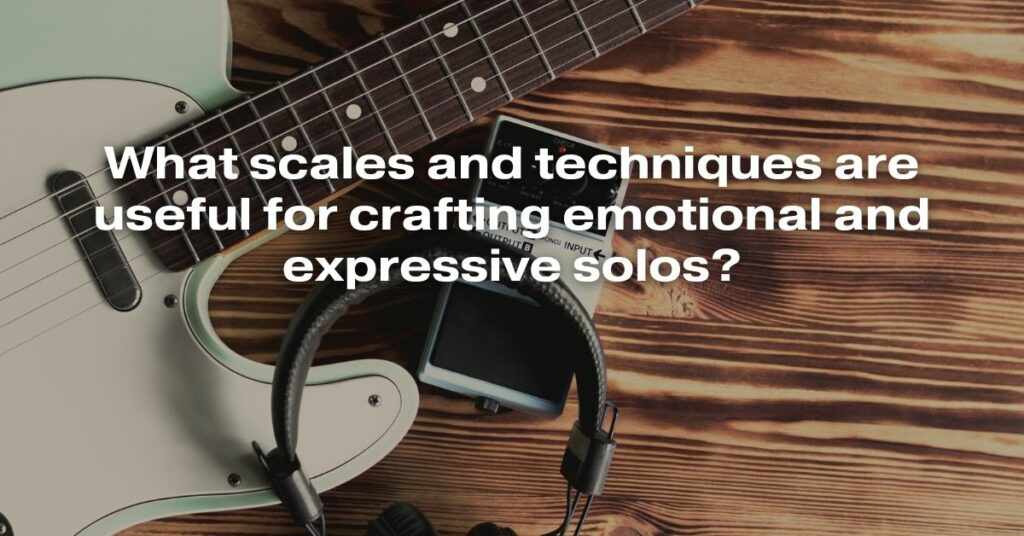Music has the incredible power to evoke emotions, create moods, and communicate feelings without saying a word. When it comes to crafting emotional and expressive guitar solos, musicians often rely on a combination of scales and techniques to convey their innermost thoughts and sentiments. In this article, we will explore some of the most effective scales and techniques that can elevate your guitar solos, allowing you to pour your emotions into your music and create a profound connection with your audience.
1. The Importance of Emotion in Guitar Solos
Before diving into the technical aspects, it’s crucial to understand the significance of emotion in music. Emotion is the driving force behind any memorable guitar solo. It’s what allows listeners to connect with the music on a deep, personal level. Whether it’s the raw aggression of a blues solo or the melancholic beauty of a jazz ballad, the emotional content is what sets a great solo apart from a mediocre one.
2. Choosing the Right Scale
The choice of scale plays a pivotal role in shaping the emotional character of a guitar solo. Different scales convey different moods and emotions. Here are a few examples:
Blues Scale: The blues scale, with its flattened 3rd and 7th degrees, is renowned for its expressive potential. It’s the foundation of countless emotional blues solos, allowing musicians to infuse their playing with a sense of longing and intensity.
Dorian Mode: The Dorian mode, a minor scale with a natural 6th degree, is often used in jazz and fusion music. It has a soulful, jazzy quality that can evoke feelings of introspection and contemplation.
Phrygian Mode: The Phrygian mode, characterized by its flattened 2nd degree, has a exotic, mysterious sound. It’s frequently used in metal and flamenco music to create intense, passionate solos.
Major Scale: While major scales are typically associated with happier, uplifting emotions, they can also be used in a bittersweet or nostalgic context. Modulating between major and minor scales can add complexity and depth to your solos.
3. Techniques for Expressive Playing
In addition to choosing the right scale, mastering certain techniques can greatly enhance the expressiveness of your guitar solos:
Bending: Bending notes allows you to inject your solos with vocal-like qualities. You can bend notes slightly for a subtle, plaintive effect or perform wide bends for dramatic, emotive impact.
Vibrato: Vibrato is the rapid variation of pitch around a central note. A controlled vibrato can add warmth and emotion to sustained notes, making your solos sing and resonate with feeling.
Slides and Hammer-ons/Pull-offs: Slides between notes and hammer-ons/pull-offs create smooth, legato phrases. These techniques can mimic the human voice and add a sense of fluidity and emotion to your solos.
Dynamics and Phrasing: Pay attention to your picking dynamics and phrasing. Experiment with playing softly and loudly to create contrast in your solos. Thoughtful phrasing, including pauses and articulation, can convey a wide range of emotions.
4. Personal Expression and Experimentation
While scales and techniques provide a framework, true emotional expression in guitar solos comes from within. Don’t be afraid to experiment and let your creativity guide you. Use your solos as a canvas to express your unique emotions and experiences. Sometimes, the most powerful and moving solos are the ones that break free from traditional constraints and speak directly from the heart.
Conclusion
Crafting emotional and expressive guitar solos is a journey that requires a deep understanding of scales, techniques, and, most importantly, your own emotions. By choosing the right scale, mastering expressive techniques, and infusing your personal experiences into your playing, you can create solos that resonate with listeners on a profound level. Remember, the key is not just to play the notes, but to tell a story, share an emotion, and connect with your audience in a way that words alone cannot. So, pick up your guitar, explore different scales, experiment with techniques, and let your emotions guide your fingers – you might just discover a whole new world of expressive possibilities in your solos.


